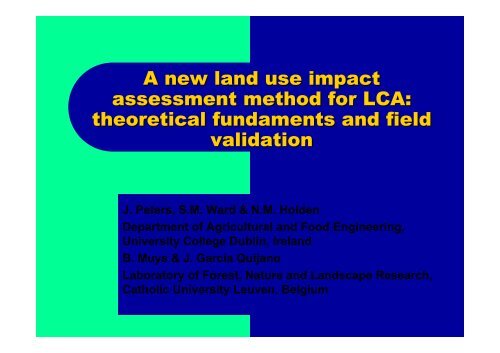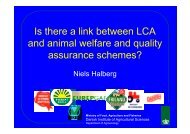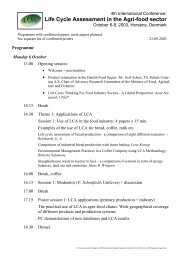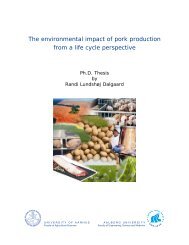A new land use impact assessment method for LCA ... - LCAfood.dk
A new land use impact assessment method for LCA ... - LCAfood.dk
A new land use impact assessment method for LCA ... - LCAfood.dk
You also want an ePaper? Increase the reach of your titles
YUMPU automatically turns print PDFs into web optimized ePapers that Google loves.
A <strong>new</strong> <strong>land</strong> <strong>use</strong> <strong>impact</strong><br />
<strong>assessment</strong> <strong>method</strong> <strong>for</strong> <strong>LCA</strong>:<br />
theoretical fundaments and field<br />
validation<br />
J. Peters, S.M. Ward & N.M. Holden<br />
Department of Agricultural and Food Engineering,<br />
University College Dublin, Ire<strong>land</strong><br />
B. Muys & J. García Quijano<br />
Laboratory of Forest, Nature and Landscape Research,<br />
Catholic University Leuven, Belgium
1. Introduction<br />
• Many human activities have spatial needs, especially<br />
agriculture and <strong>for</strong>estry<br />
• Land <strong>use</strong> <strong>impact</strong> category important in <strong>LCA</strong>’s of these<br />
activities<br />
• Several <strong>method</strong>s proposed, no consensus (COST E9)<br />
⇒ Need <strong>for</strong> <strong>new</strong> <strong>method</strong> <strong>for</strong> <strong>land</strong> <strong>use</strong> <strong>impact</strong><br />
<strong>assessment</strong>, based on strenghts of proposals
2.1. New <strong>method</strong>: basic<br />
concept and reference system<br />
• Basic concept: Ecosystem exergy<br />
Goal function of all ecosystems is to maximize<br />
their exergy i.e. to maximize their buffering<br />
capacity <strong>for</strong> external energy flows (Bendoricchio<br />
and Joergensen 1997)<br />
• Reference system: <strong>for</strong> any site the potential<br />
natural vegetation (climax) is the system with<br />
highest energetic control, highest natural exergy<br />
level <strong>for</strong> that site
2.2. New <strong>method</strong>: <strong>method</strong>ology<br />
<strong>impact</strong> <strong>assessment</strong><br />
(i)<br />
(ii)<br />
(iii)<br />
(iv)<br />
Stratification<br />
Indicator <strong>assessment</strong><br />
Aggragation<br />
Expressing results per FU <strong>for</strong> <strong>land</strong> <strong>use</strong> and<br />
<strong>land</strong> <strong>use</strong> change
(i) Stratification<br />
Area assessed is divided in homogenous sites<br />
according:<br />
1/ reference system<br />
2/ actual <strong>land</strong> <strong>use</strong><br />
LU a<br />
LU b LU c<br />
Ref 1<br />
Ref 2
(ii) Indicator <strong>assessment</strong><br />
• 17 quantitative indicators divided over 4<br />
themes: soil, water, vegetation cover and<br />
biodiversity<br />
• Indicator scores (∆Q) indicate difference in<br />
quality between actual <strong>land</strong> <strong>use</strong> and reference<br />
state
Code Indicator Calculation Reference state<br />
S1 Soil ⎛ areaaff<br />
*( permref<br />
− perm ) ⎞<br />
perm ref<br />
act<br />
compaction ⎜<br />
⎟*100<br />
*<br />
⎝ areatot<br />
permref<br />
⎠<br />
S2<br />
S3<br />
Soil structure<br />
disturbance by<br />
ploughing,<br />
etc.<br />
Soil erosion<br />
⎛ areaaff<br />
* depth times ⎞<br />
S2 ⎜<br />
* ⎟<br />
*100<br />
⎝ areatot<br />
rot ⎠<br />
⎛100*<br />
USLE ⎞<br />
⎜<br />
⎟*100<br />
⎝ Soil depth ⎠<br />
No soil work<br />
soil erosion ref<br />
S4<br />
S5<br />
Cation<br />
Exchange<br />
Capacity<br />
(CEC)<br />
Base<br />
Saturation<br />
(BS)<br />
⎛<br />
⎜<br />
CEC<br />
1 −<br />
⎝ CEC<br />
⎛<br />
⎜<br />
BS<br />
1 −<br />
⎝ BS<br />
act<br />
ref<br />
act<br />
ref<br />
⎞<br />
⎟*100<br />
⎠<br />
⎞<br />
⎟*100<br />
⎠<br />
CEC ref<br />
BS ref
Code Indicator Calculation Reference state<br />
W1 Evapotranspiration<br />
(ET) ⎛ ⎞<br />
ET<br />
⎜<br />
ET<br />
ref<br />
1 −<br />
act<br />
⎟*<br />
100<br />
⎜<br />
⎝<br />
ET<br />
ref<br />
⎟<br />
⎠<br />
W2<br />
SR<br />
P − ET<br />
Surface<br />
runoff (SR) * 100<br />
SR ref
Code Indicator Calculation Reference state<br />
V1 Total<br />
⎛ ⎞<br />
TAB<br />
aboveground ⎜<br />
TAB<br />
ref<br />
1 −<br />
act<br />
⎟ *100<br />
living biomass<br />
⎝ TAB<br />
ref ⎠<br />
(TAB)<br />
V2<br />
V3<br />
Leaf area<br />
index (LAI) ⎞<br />
⎜<br />
LAI<br />
act<br />
1 ⎟ * 100<br />
⎛<br />
−<br />
⎜<br />
⎝ LAI<br />
ref<br />
Vegetation<br />
height (H) ⎞<br />
⎜<br />
H<br />
act<br />
1 ⎟ * 100<br />
⎛<br />
−<br />
⎜<br />
⎝ H<br />
ref<br />
⎟<br />
⎠<br />
⎟<br />
⎠<br />
LAI ref<br />
H ref<br />
V4<br />
Free Net<br />
Primary<br />
Production<br />
(fNPP)<br />
⎡<br />
⎢1<br />
−<br />
⎢⎣<br />
⎛<br />
⎜<br />
⎝<br />
NPP<br />
act<br />
NPP<br />
− AH<br />
ref<br />
⎞⎤<br />
⎟<br />
⎥<br />
⎠⎥⎦<br />
*100<br />
NPP ref<br />
V5<br />
Crop biomass<br />
⎛<br />
⎜<br />
⎝<br />
crop<br />
total<br />
biomass<br />
biomass<br />
⎞<br />
⎟ *100<br />
⎠<br />
No crop species<br />
or harvest
Code Indicator Calculation Reference state<br />
B1 Artificial<br />
No irrigation or<br />
⎡⎛ area<br />
⎤<br />
change of<br />
irr+<br />
area<br />
drain<br />
⎞<br />
⎢<br />
⎥ *100<br />
water balance<br />
⎜<br />
⎟<br />
drainage<br />
⎣⎝<br />
total area<br />
⎠⎦<br />
B2<br />
Liming,<br />
fertilisation,<br />
empoverishment<br />
⎡⎛<br />
area<br />
⎢⎜<br />
⎢⎣<br />
⎝ area<br />
aff<br />
tot<br />
times<br />
*<br />
rot<br />
B2<br />
⎞⎤<br />
⎟<br />
⎥ *100<br />
⎠⎥⎦<br />
No area affected<br />
B3<br />
Biocides<br />
⎡⎛<br />
⎢<br />
⎜<br />
⎢⎣<br />
⎝<br />
area<br />
area<br />
aff<br />
tot<br />
times<br />
*<br />
rot<br />
B3<br />
⎞⎤<br />
⎟⎥<br />
*100<br />
⎠⎥⎦<br />
No area affected<br />
B4<br />
Canopy cover<br />
of exotic plant ⎛ Ex ⎞<br />
species (Ex)<br />
⎜ ⎟ * 100<br />
⎜<br />
⎝<br />
total<br />
cover<br />
⎟<br />
⎠<br />
100% native<br />
species<br />
B5<br />
Number of<br />
plant species<br />
(Sp)<br />
⎛<br />
⎜1<br />
−<br />
⎝<br />
Sp<br />
Sp<br />
act<br />
ref<br />
⎞<br />
⎟*100<br />
⎠<br />
Sp ref
Human <strong>impact</strong> ∼ ecosystem exergy level<br />
Impact score<br />
100<br />
∆Q<br />
actual <strong>land</strong> <strong>use</strong><br />
reference system<br />
0<br />
-25<br />
Time
(iii) Aggregation<br />
• 17 indicators are aggregated in 4 themes: soil<br />
(S), water (W), vegetation (V) and biodiversity<br />
(B)<br />
• Within 1 theme: each indicator same weight<br />
n<br />
∑<br />
∆ Q<br />
∆Q<br />
Si<br />
Wj<br />
i = 1 j = 1<br />
∆ Q<br />
S<br />
=<br />
where N = 5<br />
∆QW<br />
=<br />
where M = 2<br />
N<br />
M<br />
m<br />
∑<br />
x<br />
∑<br />
p = 1<br />
∆Q<br />
Vp<br />
∆Q<br />
V<br />
=<br />
where X = 5<br />
∆Q<br />
B<br />
=<br />
where Y = 5<br />
X<br />
Y<br />
y<br />
∑<br />
q = 1<br />
∆Q<br />
Bq
(iv) Expressing results per FU <strong>for</strong><br />
<strong>land</strong> <strong>use</strong><br />
<strong>use</strong> of <strong>land</strong> during certain time<br />
S<br />
S<br />
= ∆Q<br />
* ( area × time ) * FU<br />
S<br />
FU<br />
−1<br />
S<br />
W<br />
= ∆Q<br />
* ( area × time ) * FU<br />
W<br />
FU<br />
−1<br />
S<br />
V<br />
= ∆Q<br />
* ( area × time ) * FU<br />
V<br />
FU<br />
−1<br />
S<br />
B<br />
= ∆Q<br />
* ( area × time ) * FU<br />
B<br />
FU<br />
−1
(iv) Expressing results per FU <strong>for</strong><br />
<strong>land</strong> <strong>use</strong> change<br />
abrupt change in ecosystem quality by <strong>land</strong> <strong>use</strong><br />
change<br />
S<br />
i<br />
[ ] ( )<br />
−1<br />
∆Q<br />
− ∆Q<br />
* area × time<br />
= FU<br />
2 1<br />
FU<br />
*<br />
<strong>for</strong> i = soil, water, vegetation and biodiversity
3. New <strong>method</strong>: field validation<br />
3.1. Test scenario definition<br />
• Multifunctional <strong>for</strong>est in Belgium (TEMP multi <strong>for</strong>)<br />
• Short rotation coppice in Belgium (TEMP en <strong>for</strong>)<br />
• Eucalypt plantation in Spain (MED eucalypt)<br />
• Tropical rain<strong>for</strong>est conservation (TROP <strong>land</strong> <strong>use</strong>)<br />
• Mediterranean pine plantation (MED <strong>land</strong> <strong>use</strong>)<br />
• Subtropical agro<strong>for</strong>estry plantation (SUBTROP<br />
<strong>land</strong> <strong>use</strong>)
3.2. Results
100<br />
80<br />
60<br />
40<br />
20<br />
0<br />
-20<br />
biodiversity<br />
vegetation<br />
water<br />
soil<br />
MED fynbos<br />
SUBTROP kloof <strong>for</strong>est<br />
SUBTROP infrastructure<br />
SUBTROP secondary <strong>for</strong>est<br />
SUBTROP wet<strong>land</strong><br />
SUBTROP avocado<br />
SUBTROP eucalypt<br />
MED fire belt<br />
MED infrastructure<br />
MED indigenous <strong>for</strong>est<br />
MED pine<br />
TROP agricultural <strong>land</strong> <strong>use</strong><br />
TROP shifting cultivation<br />
TROP selective logging<br />
TROP primary <strong>for</strong>est<br />
MED eucalypt<br />
TEMP en <strong>for</strong><br />
TEMP multi <strong>for</strong><br />
Thematic score (∆Qi ) [/]
100<br />
80<br />
60<br />
40<br />
20<br />
0<br />
-20<br />
biodiversity<br />
vegetation<br />
water<br />
soil<br />
MED fynbos<br />
SUBTROP kloof <strong>for</strong>est<br />
SUBTROP infrastructure<br />
SUBTROP secondary <strong>for</strong>est<br />
SUBTROP wet<strong>land</strong><br />
SUBTROP avocado<br />
SUBTROP eucalypt<br />
MED fire belt<br />
MED infrastructure<br />
MED indigenous <strong>for</strong>est<br />
MED pine<br />
TROP agricultural <strong>land</strong> <strong>use</strong><br />
TROP shifting cultivation<br />
TROP selective logging<br />
TROP primary <strong>for</strong>est<br />
MED eucalypt<br />
TEMP en <strong>for</strong><br />
TEMP multi <strong>for</strong><br />
Thematic score (∆Qi ) [/]
100<br />
80<br />
60<br />
40<br />
20<br />
0<br />
-20<br />
biodiversity<br />
vegetation<br />
water<br />
soil<br />
MED fynbos<br />
SUBTROP kloof <strong>for</strong>est<br />
SUBTROP infrastructure<br />
SUBTROP secondary <strong>for</strong>est<br />
SUBTROP wet<strong>land</strong><br />
SUBTROP avocado<br />
SUBTROP eucalypt<br />
MED fire belt<br />
MED infrastructure<br />
MED indigenous <strong>for</strong>est<br />
MED pine<br />
TROP agricultural <strong>land</strong> <strong>use</strong><br />
TROP shifting cultivation<br />
TROP selective logging<br />
TROP primary <strong>for</strong>est<br />
MED eucalypt<br />
TEMP en <strong>for</strong><br />
TEMP multi <strong>for</strong><br />
Thematic score (∆Qi ) [/]
100<br />
80<br />
60<br />
40<br />
20<br />
0<br />
-20<br />
biodiversity<br />
vegetation<br />
water<br />
soil<br />
MED fynbos<br />
SUBTROP kloof <strong>for</strong>est<br />
SUBTROP infrastructure<br />
SUBTROP secondary <strong>for</strong>est<br />
SUBTROP wet<strong>land</strong><br />
SUBTROP avocado<br />
SUBTROP eucalypt<br />
MED fire belt<br />
MED infrastructure<br />
MED indigenous <strong>for</strong>est<br />
MED pine<br />
TROP agricultural <strong>land</strong> <strong>use</strong><br />
TROP shifting cultivation<br />
TROP selective logging<br />
TROP primary <strong>for</strong>est<br />
MED eucalypt<br />
TEMP en <strong>for</strong><br />
TEMP multi <strong>for</strong><br />
Thematic score (∆Qi ) [/]
100<br />
80<br />
60<br />
40<br />
20<br />
0<br />
-20<br />
biodiversity<br />
vegetation<br />
water<br />
soil<br />
MED fynbos<br />
SUBTROP kloof <strong>for</strong>est<br />
SUBTROP infrastructure<br />
SUBTROP secondary <strong>for</strong>est<br />
SUBTROP wet<strong>land</strong><br />
SUBTROP avocado<br />
SUBTROP eucalypt<br />
MED fire belt<br />
MED infrastructure<br />
MED indigenous <strong>for</strong>est<br />
MED pine<br />
TROP agricultural <strong>land</strong> <strong>use</strong><br />
TROP shifting cultivation<br />
TROP selective logging<br />
TROP primary <strong>for</strong>est<br />
MED eucalypt<br />
TEMP en <strong>for</strong><br />
TEMP multi <strong>for</strong><br />
Thematic score (∆Qi ) [/]
100<br />
80<br />
60<br />
40<br />
20<br />
0<br />
-20<br />
biodiversity<br />
vegetation<br />
water<br />
soil<br />
MED fynbos<br />
SUBTROP kloof <strong>for</strong>est<br />
SUBTROP infrastructure<br />
SUBTROP secondary <strong>for</strong>est<br />
SUBTROP wet<strong>land</strong><br />
SUBTROP avocado<br />
SUBTROP eucalypt<br />
MED fire belt<br />
MED infrastructure<br />
MED indigenous <strong>for</strong>est<br />
MED pine<br />
TROP agricultural <strong>land</strong> <strong>use</strong><br />
TROP shifting cultivation<br />
TROP selective logging<br />
TROP primary <strong>for</strong>est<br />
MED eucalypt<br />
TEMP en <strong>for</strong><br />
TEMP multi <strong>for</strong><br />
Thematic score (∆Qi ) [/]
100<br />
80<br />
60<br />
40<br />
20<br />
0<br />
-20<br />
biodiversity<br />
vegetation<br />
water<br />
soil<br />
MED fynbos<br />
SUBTROP kloof <strong>for</strong>est<br />
SUBTROP infrastructure<br />
SUBTROP secondary <strong>for</strong>est<br />
SUBTROP wet<strong>land</strong><br />
SUBTROP avocado<br />
SUBTROP eucalypt<br />
MED fire belt<br />
MED infrastructure<br />
MED indigenous <strong>for</strong>est<br />
MED pine<br />
TROP agricultural <strong>land</strong> <strong>use</strong><br />
TROP shifting cultivation<br />
TROP selective logging<br />
TROP primary <strong>for</strong>est<br />
MED eucalypt<br />
TEMP en <strong>for</strong><br />
TEMP multi <strong>for</strong><br />
Thematic score (∆Qi ) [/]
100<br />
80<br />
60<br />
40<br />
20<br />
0<br />
-20<br />
biodiversity<br />
vegetation<br />
water<br />
soil<br />
MED fynbos<br />
SUBTROP kloof <strong>for</strong>est<br />
SUBTROP infrastructure<br />
SUBTROP secondary <strong>for</strong>est<br />
SUBTROP wet<strong>land</strong><br />
SUBTROP avocado<br />
SUBTROP eucalypt<br />
MED fire belt<br />
MED infrastructure<br />
MED indigenous <strong>for</strong>est<br />
MED pine<br />
TROP agricultural <strong>land</strong> <strong>use</strong><br />
TROP shifting cultivation<br />
TROP selective logging<br />
TROP primary <strong>for</strong>est<br />
MED eucalypt<br />
TEMP en <strong>for</strong><br />
TEMP multi <strong>for</strong><br />
Thematic score (∆Qi ) [/]
100<br />
80<br />
60<br />
40<br />
20<br />
0<br />
-20<br />
biodiversity<br />
vegetation<br />
water<br />
soil<br />
MED fynbos<br />
SUBTROP kloof <strong>for</strong>est<br />
SUBTROP infrastructure<br />
SUBTROP secondary <strong>for</strong>est<br />
SUBTROP wet<strong>land</strong><br />
SUBTROP avocado<br />
SUBTROP eucalypt<br />
MED fire belt<br />
MED infrastructure<br />
MED indigenous <strong>for</strong>est<br />
MED pine<br />
TROP agricultural <strong>land</strong> <strong>use</strong><br />
TROP shifting cultivation<br />
TROP selective logging<br />
TROP primary <strong>for</strong>est<br />
MED eucalypt<br />
TEMP en <strong>for</strong><br />
TEMP multi <strong>for</strong><br />
Thematic score (∆Qi ) [/]
4. Discussion and conclusion<br />
• Assessment fully quantitative<br />
• Assessment in different climatic and<br />
geographical regions operational<br />
• Workable definition of reference system<br />
• Comparing <strong>land</strong> <strong>use</strong> from different sites &<br />
climates possible<br />
• Results can be expressed per FU<br />
• Linearity requirement satisfied: doubling FU<br />
leads to double <strong>impact</strong> score
5. Recommendations<br />
• Further <strong>method</strong> testing is needed, with special<br />
attention <strong>for</strong> indicator selection.<br />
• Minimum indicator score threshold of –25<br />
should be revised to solve sensitivity problems.<br />
• Vegetation with highest exergy level i.e.<br />
potential natural vegetation is a workable<br />
reference vegatation but problems rise when<br />
no natural patches are left. Literature data can<br />
be <strong>use</strong>d with lower reliability.
• Indicators S2 (soil erosion) and W2 (surface<br />
runoff) should be redesigned, so that the<br />
reference vegetation has the 0 score.<br />
• Themes are not comparable within the same<br />
<strong>land</strong> <strong>use</strong> <strong>assessment</strong>.
Thanks!







